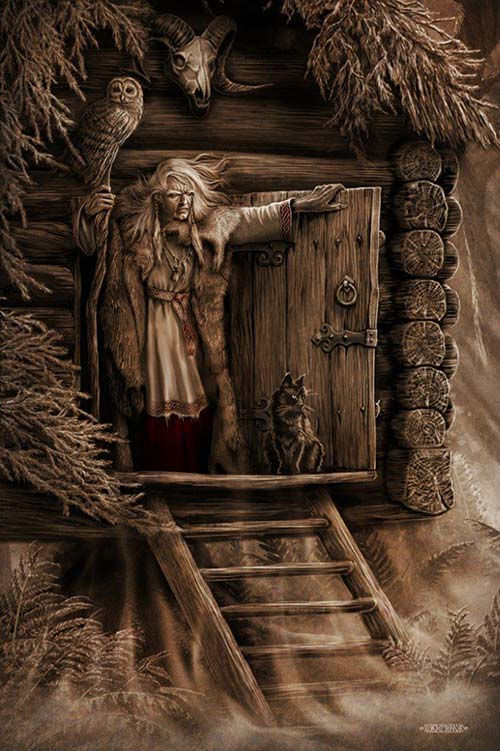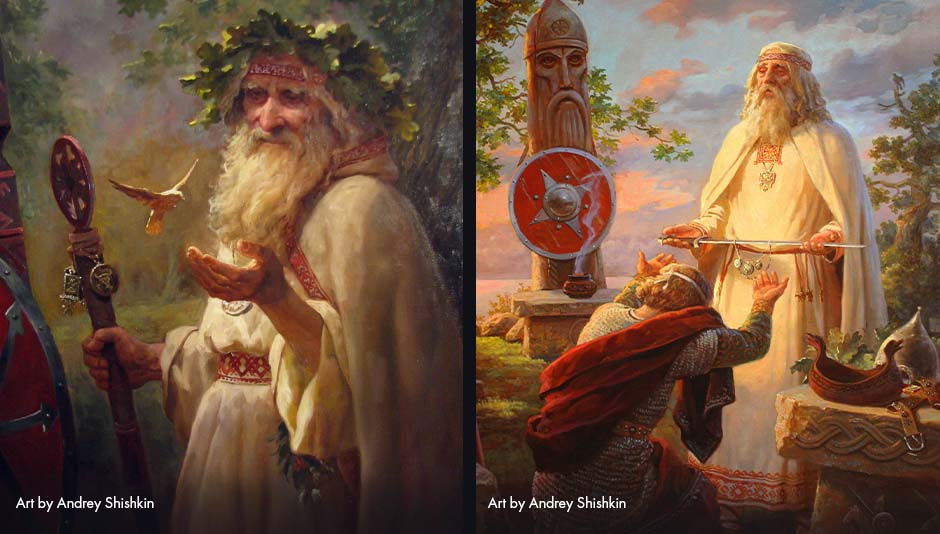Gods and Monsters of the Fire Salamander World: Baba Yaga - Part 1
- nmthornauthor
- Oct 20, 2023
- 5 min read
A TERRIFYING WITCH OR A POWERFUL GODDESS?

Undoubtedly, Baba Yaga is one of the best-known characters in Slavic mythology. At the same time, it’s probably one of the most complex and misrepresented figures as well. Of course, I am not a scholar of Slavic lore, and I don’t consider myself a specialist on the subject. Today, however, I’d like to share a few things I know about this fascinating and complex character.
Even in Slavic fairy tales, Baba Yaga has three very different incarnations:
1. Baba Yaga, the Warrior. She is the hero who owns the legendary Sword Kladenest. She is not afraid to face the strongest and most powerful warriors, fighting them as their equals.
2. Baba Yaga, the Abductor. She is an evil witch who abducts little children and takes them deep into a forest where she dwells in a hut on chicken legs.
3. Baba Yaga, the Giver. She meets the hero of a story, feeds them, gives them the opportunity to rest, and gifts them with magical objects that assist them on their journey. She also gives them the most helpful advice, which allows them to complete their quest.
So, who is Baba Yaga? An ugly, evil sorceress (koldunia) or one of the oldest, most powerful light goddesses of the Slavic pantheon? Let’s look at both sides of this fascinating character.
BABA YAGA, THE EVIL WITCH

Nowadays, the image of Baba Yaga we’re most familiar with is that of an ugly, old hag who lives in a hut on chicken legs deep in a forest. She is depicted as a tall, skinny woman, whose one leg is made completely out of a bone. Her nose is long and hooked like the beak of an eagle, and her crooked, yellow teeth are protruding out of her lipless mouth. Her gray hair falls to her shoulders in long, disheveled strands.
The old sorceress doesn’t like to walk. Her preferred method of transportation is an iron mortar, which she propels with an iron pestle or a broom. A terrifying image, if you can imagine that. Her most common servants are crows, frogs and cats (including the infamous Cat Bayun). Remarkably, all these creatures have their own duality—the wisdom and the deadly threat.
Her house—the famous hut on chicken legs—always faces the forest, turning its back on the rest of the world. This clearly demonstrates the antisocial and unfriendly personality of the owner. All the heroes of Slavic fairy tales must say magic words to make the hut turn around and face them: “Hut, hut, turn your back to the forest and your face to me.” The fence surrounding the hut is made of human bones and decorated with human skulls. The gate is described as a terrifying maw with sharp fangs.
In most cases, Baba Yaga’s house is located on the border between the world of the living (the Yav) and the realm of the dead (the Dark Nav). So, it won’t come as a surprise that quite often, Baba Yaga is represented as a guide from one realm to the next (from the Yav to the Nav). She completes the rituals, known only to her, to help the hero enter the Realm of Death.
But even in her most evil portrayal, Baba Yaga can still foresee the future and possesses the most amazing treasures and secret knowledge. When meeting a magical, fairy-tale hero, she is the only person who can tell them where and how to find an enchanted weapon, or how to defeat Koshchei the Deathless and free a beautiful maiden from his prison.
When children come across this horrifying, evil sorceress, in most cases, they manage to escape the hopeless situations. All her wicked scams go to waste, and from an evil kidnapper Baba Yaga turns into a giver.
Why is that? If she is pure, unadulterated evil, shouldn’t she just eat those unfortunate children, or kill the hero who stumbled across her hut on their journey?
It doesn’t make any sense, does it?
Maybe it does, though.
Let’s look at the other side of Baba Yaga to explain this phenomenon.
BABA YAGA, THE GODDESS (BEREGINYA)

Stop... Take a deep breath… and forget everything you know about Baba Yaga from Russian fairy tales and popular media.
Because from this point on, we’re going to talk about her other side—the lost image of Slavic Baba Yaga, a light goddess-bereginya (goddess-protector), a beautiful, wise and compassionate woman who possesses secret knowledge (Vedas) and countless magical treasures.
In the old Slavic mythology, Baba Yaga has a few names—Yaginya, Yaginishna, Yaga, Yozhka, Boorya-Yaga (Storm-Yaga).
So, who is Yaginya?
According to Slavic lore, Yaginya was the daughter of two regular mortals. After their death, the Slavic goddess of Destiny, Makosh, found her and adopted her. With time, Yaginya turned into a wise woman who understood the balance of nature and the forces that drive the entire universe. She became a goddess who helped people find the right path, and even later on, Russian fairy tales couldn’t take this quality from her.
Ancient Slavs loved Yaginya. After all, she was the wife of Veles, the god of Magic, Wisdom and Three Realms. But we’ll talk about Yaginya and Veles, and their heartbreaking story of love, loyalty and betrayal in part 2 of this blog.
Some believed that Yaginya, in her power, surpassed most of the male heroes and spiritual leaders of Slavic lore. She underwent complex inner changes that allowed her to move freely between the world of the living and the realm of Death. Not many gods and heroes of Slavic mythology can say that they can do that.
Long ago, people believed that only men could rise to the status of a god, acquiring the necessary skills and knowledge to do so.
Yaginya proved them all wrong.
She is a woman who became a goddess. Yaginya—the immortal goddess of Paths in the World of the Yav (The World of Reality, where we all live).
The ancient Slavs depicted Matushka Yaginya, meaning ‘Mother Yaginya’, as a beautiful woman with long, blonde braids adorned with intricate Slavic jewelry. Her clothes were always light and clean, and she wore golden shoes (which had magical properties, by the way).
An Interesting fact is that Slavs used to call Yaginya “Matushka” (Mother) because of her deep love for children. One of the legends has it that after the Great War between Realms, Yaginya gathered all orphaned children in her house. She took care of them and taught them the sacred knowledge of the Vedas.
There you have it. So, which side of Baba Yaga do you prefer? The ugly, evil sorceress or the wise light goddess of Paths?
If you’ve read The Burns Defiance, the third book of the Fire Salamander Chronicles, or The Shadow Supremacy, the sixth book of the Shadow Enforcer series, you know which side of Baba Yaga makes an appearance in the Salamanderverse.
References:
Image Credit:
Baba Yaga. Art by Igor Ozhiganov.
Bereginya. Art by Andrey Shishkin. Artist's website, № 305 Берегиня

Enter the Fire Salamander World, where magic and ancient myths are real, and things are not what they appear to be.
If you haven't done it yet, you can download "The Burns Path”, a prequel to the Fire Salamander Chronicles Urban Fantasy series, for FREE on my website. The events of this 49,000-word novella occur before the Burns Fire, and it can be read as a standalone book.





Looking forward to next